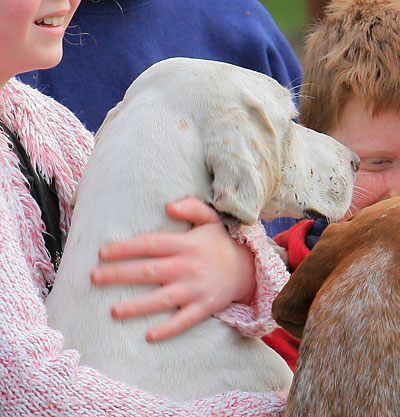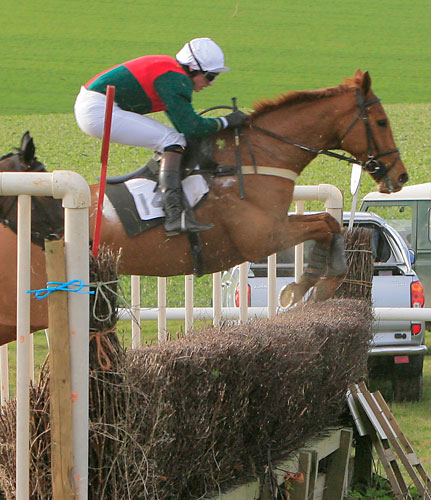How to freeze subject movement
Photos can sometimes get blurred because the subject moves whilst the shutter is open. To avoid this you need to set a fast enough shutter speed so that any such movement is negligible. This page discusses how to do this and provides a Javascript calculator for estimating the required shutter speed for different kinds of subjects.
When I first bought cameras, in the 1960s, a common top shutter speed was 1/500th of a second, and 1/1000th would only be found on top of the range professional cameras. Today, 1/8000th is commonly available.
Somehow, over the years I got into the habit of thinking that 1/125th would be quite fast enough to freeze movement in, say, a group of people, and that 1/1000th would be enough to freeze anything, even a horse race. But my recent experience has made me realise that these lazy assumptions simply aren't true.
Some examples

In this picture of children hugging a hound, which is a crop from a larger photo, everything is pin sharp except the girl's hand. Yet it is taken at 1/200th.
The truth is that most of the time people stay fairly still, but occasionally they are capable of making really quite rapid movements, and a faster shutter speed is needed if you want to avoid such blur.
Try sitting down and moving your hand from your knee to your chin and back ten times. I did this easily in 8 seconds and my hand was moving over a distance of 0.5 metre. That equates to a speed of 1.25 metres/second. As we shall see, a surprisingly fast shutter speed is needed to freeze this.
Canon 5D 200mm f8 1/200

In this horse race, which is also a crop from a larger photo, I prefocussed on the middle of the hedge and took the photo at 1/800th. The hedge is sharp but the horse and rider are not. Of course I could, and probably should, have used a slower shutter speed and panned the camera with the rider, thus keeping the horse sharp (except probably its hooves) and blurring the background. However, I am interested here to know what shutter speed I should have used to freeze this horse without panning.
Canon 5D 90mm f6.3 1/800
The theory of freezing subject motion
Suppose our subject - the horse, the girl's fingers, a basket-ball player or whatever - is moving across the camera's field of view at a known speed V. Whilst the shutter is open for 1/N th of a second, the subject will move a distance V/N.
This subject is imaged by our lens onto the film or sensor of our camera. To do this it applies a large optical reduction, because the subject is quite large and our sensor is pretty small. Assuming we are not in the field of macro photography, the factor by which the lens reduces the size of the subject when imaging it on the sensor is given by R = F/D where F is the focal length of our lens and D is the distance between camera and subject.
So the distance that the subject's image moves across the sensor whilst the shutter is open is R*V/N.
To avoid this movement causing the image to be blurred, we need to ensure that this distance is less than some acceptable limit. So we now have to decide what would be an acceptable limit.
One approach would be to take a very strict view and say "I don't want the image on the sensor moving by more than half the distance between pixels". That would give a figure of about 3-4 microns and would certainly ensure that the image remained sharp even if examined by pixel peepers at 100% in Photoshop. However, that would be a very demanding criterion that would result in impossibly high shutter speeds.
Alternatively, one can consider how big a print one is going to make from the image, what distance one is going to view that print at, and how discriminating the average human eye is. The experienced reader will feel the phrase "circle of confusion" bubbling up at this point. I don't intend to get into that because it is explained much better by Sean McHugh here and by Bob Atkins here (albeit in a different context, that of depth of field). Suffice to say that circle of confusion considerations lead one to choose a figure of about 33 microns for average eyesight, or about 11 microns for people with 20:20 vision.
I simply decided to pick a figure of 20 microns as being a reasonable compromise between these various alternatives. So I am saying that I don't want subject motion to move the image across the sensor by more than C=20 microns whilst the shutter is open.
Finally, we need to note that all the above figures for C apply only to a 35mm film camera or a DSLR with a full-frame sensor. For digital cameras with smaller sensors, C needs to be divided by the camera's crop factor.
Putting this together, we want R*V/N = (F*V)/(D*N) ≤ C. Rearranging, we want N ≥ (F*V)/(D*C).
Obviously enough, the faster the subject is moving (the bigger V is) then the bigger the value of N and hence the faster the shutter speed we require. (Recall that N is the denominator of the shutter speed in this formula.)
Not quite so obvious, the nearer the subject is to the camera (the smaller D is) or the longer our lens (the bigger F is), then the faster is the shutter speed we need. This is easy to imagine if you consider looking with your eyes at a passing train: if the train is two metres in front of you it's going to be much more blurred than if it's 30 metres away.
Shutter speed calculator
You can use the calculator below to derive the shutter speed you need to freeze subject movement, provided you know or can estimate the information in the brown box. This calculator won't work unless you enable Javascript in your browser for this page.
Let's try it with the two example situations I gave at the top of this article.
I estimated that the girl's hand might be moving at 1.25 metres/second. The focal length of the lens was 200mm and I guess that the girl was about 10 metres away from me. I was using a Canon EOS 5D DSLR which has a crop factor of 1. Putting these figures into the calculator produces a required shutter speed of 1/1250th of a second. Compare this with the 1/200th I actually used.
I have no idea how fast the horses were racing; I was just before the finishing post so let's guess at 20 MPH. The lens focal length was 90mm and I reckon the horse was about 8 metres away from me. The calculator says I should have used a shutter speed of at least 1/5029th of a second. Compare this with the 1/800th I actually used. (The 5D will actually go up to 1/8000)
If the subject is moving towards or away from the camera, rather than across its field of view, a slower shutter speed is ok.
Important
This whole article is just about how to set a fast enough shutter speed to avoid blurring of the image caused by movement of the subject. It has nothing to do with the different question of what shutter speed you need to avoid a blurred image due to movement of the camera when using a long lens.
The rule of thumb for the latter is 1/(focal_length_of_lens * camera_crop_factor). That rule is almost always going to produce a shutter speed much slower than that required to freeze subject movement.
Peter Facey, Winchester, England
20130525 corrected shutter speed calculator for distance units = yards or feet
20071113 minor edits
20071111 originated
Home

